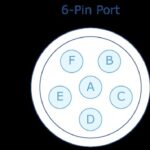Creating your own Homemade Obd2 Programmer can be a rewarding project for car enthusiasts and those interested in vehicle diagnostics and customization. This guide will walk you through the process of modifying an ELM327 OBD2 adapter to interface with an Arduino, giving you the foundation for a DIY programming tool.
First, disassemble your ELM327 adapter. Begin by removing any stickers on the enclosure. You’ll typically find four screws underneath; use a small star screwdriver to remove these. Carefully separate the enclosure to access the internal circuit board.
Image alt text: Disassembled ELM327 OBD2 adapter showing the circuit board after removing the enclosure screws, prepared for modification.
Locate the TX and RX pins on the ELM327 board. Refer to the pin-out diagram of the USB bridge chip on your specific board, as these locations can vary slightly. Solder two wires to these TX and RX pins. Exercise caution during soldering to avoid accidentally desoldering any nearby small components.
Image alt text: Close-up view of the ELM327 circuit board with wires soldered to the TX and RX pins, illustrating the connection points for Arduino integration.
To prevent conflicts and ensure proper communication with your Arduino, it’s advisable to isolate the ELM327’s USB communication with your PC. One method is to carefully cut the middle two pins on the 4-pin connector that connects the USB cable to the board. This allows the ELM327 to draw power from the USB port but prevents data communication, dedicating the serial controller to your Arduino.
Once the modifications are complete, carefully reassemble the ELM327 adapter. You can secure the enclosure with tape if the original screws are inconvenient, especially if the adapter’s location in your vehicle is tight or temporary during development.
With these steps, you’ve created a basic homemade OBD2 programmer interface. You can now connect this modified ELM327 to your Arduino and begin developing custom scripts for vehicle diagnostics, data logging, or even basic programming functionalities, opening up a world of possibilities for DIY automotive projects.
